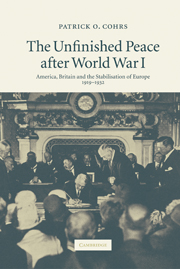Book contents
- Frontmatter
- Contents
- Acknowledgements
- List of abbreviations
- A note on the footnotes and bibliography
- Introduction
- Prologue
- 1 The wider challenges
- 2 Wilson, Lloyd George and the quest for a ‘peace to end all wars’
- 3 The ill-founded peace of 1919
- 4 The escalation of Europe's post-Versailles crisis, 1920–1923
- Part I The Anglo-American stabilisation of Europe, 1923–1924
- Part II Europe's nascent Pax Anglo-Americana, 1924–1925
- Part III The unfinished transatlantic peace order: the system of London and Locarno, 1926–1929
- Epilogue
- Conclusion
- Map: Post-World War I Europe after the peace settlement of Versailles
- Bibliography
- Index
4 - The escalation of Europe's post-Versailles crisis, 1920–1923
Published online by Cambridge University Press: 21 July 2009
- Frontmatter
- Contents
- Acknowledgements
- List of abbreviations
- A note on the footnotes and bibliography
- Introduction
- Prologue
- 1 The wider challenges
- 2 Wilson, Lloyd George and the quest for a ‘peace to end all wars’
- 3 The ill-founded peace of 1919
- 4 The escalation of Europe's post-Versailles crisis, 1920–1923
- Part I The Anglo-American stabilisation of Europe, 1923–1924
- Part II Europe's nascent Pax Anglo-Americana, 1924–1925
- Part III The unfinished transatlantic peace order: the system of London and Locarno, 1926–1929
- Epilogue
- Conclusion
- Map: Post-World War I Europe after the peace settlement of Versailles
- Bibliography
- Index
Summary
At the heart of Europe's post-Versailles crisis clearly lay the unresolved German question and the latent antagonism between German revisionism and the French bid to maintain Europe's precarious status quo of 1919. This also lay at the centre of the reparations conflict overshadowing international politics between 1920 and 1923. As Keynes was only the most prominent critic to expound in 1919, there were two inextricably intertwined dimensions to the imbroglio over reparations. On one level, it was bound up with the question of who would ultimately bear the costs of the war and buttress Europe financially. On a second, even more important, level, it was inseparable from the question of who would command the power resources that nation-states still deemed necessary to safeguard their security, even in an era so marked by international interdependence.
After Versailles, the reparations conflict retained its distinct transatlantic dimension. There was and remained a de facto linkage between the reparations France and Britain demanded from Germany and their debts to America (Britain owed the United States $4.7 billion, France $4 billion – and roughly the same amount to Britain). Yet successive Republican administrations after 1920 refused to acknowledge this nexus to forestall the formation of a European debtor coalition that could ultimately force America to collect its dues from Germany. At the same time, Wilson's successor Warren Harding and even more so the Republican-dominated Congress insisted that there could not even be a partial debt-relief for America's wartime allies. Thus a circulus vitiosus emerged.
- Type
- Chapter
- Information
- The Unfinished Peace after World War IAmerica, Britain and the Stabilisation of Europe, 1919–1932, pp. 68 - 76Publisher: Cambridge University PressPrint publication year: 2006



